I am headed up to Phoenix for the annual SAR West gun show this weekend, where I expect to have a lot of fun, meet a bunch of you guys, and come home with substantially less cash and more guns. What better way to spend a weekend? I hope you guys in Arizona will stop by an say hi, to both myself and our sponsors who have tables – Apex Gun Parts and Allegheny Arsenal.
While I’m on the road, I have a guest post for you from a fellow named Bob Shell, who is into actually shooting some of the particularly unusual obsolete cartridges that we see in the milsurp world. If you enjoy this piece you should check out his other articles, at Bob Shell’s Blog.
Shooting the 6.5mm Dutch
by Bob Shell
Brought out in 1892 it replaced the 43 Beaumont, which is a large caliber black powder round that was typical of that period. The Netherlands came into the smokeless era with the 6.5 X 53 round. This is a rimmed cartridge brought out in 1895 for the Dutch and Romanian rifles of 1892 and 1895. It seems to be a forerunner of the 6.5 X 54 Mannlicher-Schoenauer that was popular in the U.S. but it’s a rimmed cartridge, 1 millimeter shorter. Ballistics of the two rounds are very similar though the 6.5 M-S does have a limited popularity among hunters. Both the Dutch and Romanian rifles (and carbines) use a five shot Mannlicher-type clip that is inserted from the top. When the clip is empty it falls out through the bottom similar to a Carcano. The extractor is sturdy and when you bring back the bolt, the case hits the receiver, which will eject the round. The system is sturdy and would seldom if ever cause a problem. The sights are adjustable out to 2,000 meters but since they are crude hitting anything that far would be problematical at best. Around that period of time some of the other countries such as Japan & Italy among others were adopting 6.5’s with the same type of bullet and power factor. Military ammo was loaded with a 156 to 162 grain full metal jacket bullet at around 2300 feet per second. Military ammo was produced until around the end of WW ll but not in great quantity. No military attempted to update this round, unlike some other military powers, by using a lighter pointed bullet which would have extended its range. It has a fast twist of 1 in 7.87” according to various sources.
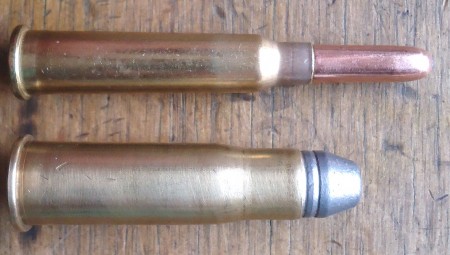
Bottom – .43 Beaumont
The 6.5 bullets are long for their weight which helps with penetration. Like most 6.5’s the paper ballistics aren’t very impressive but don’t let that fool you. They are capable of deep penetration with the 160 grain slug. That goes for all the 6.5’s. Every species of game has been taken with these types of cartridges. Karamogo Bell is said to have taken over 1000 elephants with the 6.5 rimless Mannlicher round. Those 160 grain full metal jacketed bullets gave the necessary penetration to penetrate to the elephant’s brain, quickly dispatching it. Without a doubt Bell was a good shot and more then a little lucky. His fast running probably got his bacon out of the fire a few times. WWI saw various rifles chambered for the 6.5’s in action. At one time, the British listed it as the .256 Mannlicher and produced sporting rifles for it. It probably found some favor in Africa with the smaller big game due to its light recoil and weight. I imagine that if you could get Harrington & Richardson or Thompson Center to chamber a single shot rifle for the 6.5 Dutch that would be a real sweetheart of a rifle. Of course, you could order a custom barrel for it if you are willing to pay the price for it.
The other soft points especially the heavier ones will give good penetration due to the mild velocities available. Ultra high velocities makes many bullets open up prematurely, thus cutting down on penetration. The nice thing about the smaller 6.5’s are the can use standard bullets to good effect. A .264 Winchester Magnum demands a premium bullet to obtain its best performance. Bullet selection for the 6.5 caliber is relatively good. Bullets from 85 to 160 grains are made by one or more of our manufactures. Spitzers, round nose and hollow points are available. Hornady produces a 160 grain round nose that will also give some good penetration according to some tests I have conducted. They go through dry phone books like a hot knife going through butter. The Hornady bullet is the closest to the military in weight and profile. Cast bullets are also a viable option especially for small game and plinking loads.

The rifle I used for this test is a carbine with an 18” barrel with good rifling. The action has the appearance of being strong and well made. Balance is good for carrying and hunting. It has two large locking lugs and a safety similar to the Mauser. I have no doubt that the metals and heat treatment used was the best of the day. When the safety is engaged it locks the bolt shut as well as stopping the gun from firing. I have no doubt that it is a good design. The bolt release is on the left side of the receiver. It works ok but needs a little muscle to work it. It is one of the only actions that is as smooth as the Krag. The bolt slides like greased glass. The magazine is a Mannlicher type requiring a stripper clip if you can find one. That is perhaps it’s one weakness as far as I am concerned. Old Western Scrounger may have a clip for it from time to time (ed: these are currently available from Liberty Tree Collectors). I shoot mine single shot, which is no problem for what I use it for though I have a clip.
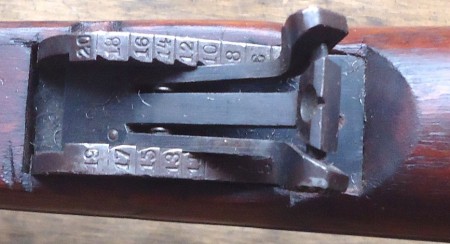
Like most of the older military rifles when you pick it up you automatically have confidence in it. At least I do. The trigger is typical military with travel and let off. Since I shoot so many military rifles I find no problem with the trigger pull. I don’t know what kind of wood it is but it is hard and of good quality. Stamped on the side is Hembrug 1916. The rear sight has mule ears somewhat like the Enfield rifle. According to Small Arms of The World, many were converted to the .303 British round in Indonesia during the 1950’s. That would say something about their strength and quality. When shooting it felt pretty comfortable, not too short or too long. I would rate the quality and finish on this rifle very high. Gunsmithing it would be possible though difficult. A scope with a side mount would be possible if you were willing to pay the tab. Peep sights may be installed if you wanted to take it hunting and your eyes were good. Also I suppose it could be rebarreled but the cost would be prohibitive for such a gun. Besides, why not leave it in its original caliber and make ammo for it? That is part of the fun, making ammo for an obsolete gun (ed: anyone who sporterizes an intact Dutch Mannlicher is going to the Special Hell).
The real problem begins when you decide to shoot it. There are a few pieces of military ammo around but it is unreliable due to age. The cases and bullets I have seen are black and probably corrosive. I haven’t attempted to shoot it due to the age. Hang fires are one of the problems with this and other older military calibers I have seen. By the way, if you insist on shooting it and have a misfire keep the rifle pointed down range for at least 60 seconds before unloading the rifle. Failure to heed this advice can cause you some real pain. Imagine having just started opening the bolt when it goes off! If you have military brass don’t use it unless you want to go to the trouble of decapping and priming the case. That is if the correct Berdan primer is available. There isn’t any American ammo company that has ever made ammo for it as far as I know. Bertram Brass from Australia has made cases for it but they are expensive and not always obtainable. Also with quality problems I have had with Bertram brass in the past I hesitate to recommend it. Maybe someone in Europe makes it but I never saw any here. If you are a reloader, you are in luck.
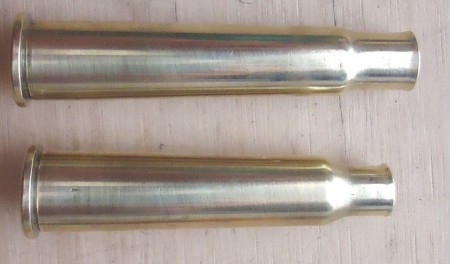
The 303 British case is perfect for use. Just trim it to 2.10” and full length size and you are in business. In a few instances you may have to trim or thin the rim but I had no such a problem. Once fired in your chamber set your sizing die so they fit with a tiny bit of feel. With sensible loads the cases will last many firings. I tried a few brands of cases including some military. For some reason the Remington cases didn’t work as well as the others. I have had that problem with Remington cases in other projects I have undertaken. Over 65% had their shoulder collapse during the sizing operation. It must be the way the brass was annealed. Winchester and Federal cases didn’t suffer the same fate. Even military cases did ok though I had some with a peculiar priming system. I discovered that even though it’s a boxer primer it had two tiny offset flash holes plus a smaller then normal center flash hole. I have a bunch that I pulled out the bullets for another project and so I trimmed them and used the original primer. After firing them I discovered the peculiar primer pockets when I tried to decap them. Even a small diameter decapping pin was too big. Anyway, commercial brass is cheap enough so that’s what I will stick to for the most part. Upon firing these cases, I observed no problems with feeding or chambering. There is a little loading data around but unless you have Cartridges of the World, you may be out of luck. Anyway, I concocted some loads that work fine in my gun. As always start a grain or two below the ones listed as max and work carefully up. The 6.5 is not a fussy round to load. Medium powders such as 4895 and VV 150 work very well with most weights of bullets. Anything slower then 4350 will cut velocities down especially with lighter bullets. Faster powders such as 3031 are ok with the lighter bullets but may jump pressure quite a bit with the 160’s even with a small increase. Winchester large rifle primers were used during the testing. Due to varying conditions and reloading practices, neither the author nor the publisher can be responsible for use of this data (ed: shooting vintage military rifles is dangerous, and will probably kill you in a spectacular manner – so use this data at your own risk).
LOAD BULLET VELOCITY COMMENTS
8 X Herco 85 grain Sierra h.p. 1255 pest load
43 X VV 150 85 grain Winchester 3068 good load
37 X IMR 4895 85 grain Sierra h.p. 2673 decent load
41 X IMR 3031 85 grain Sierra h.p. 2979 max
35 X IMR 4895 100 grain Hornady 2578 ok
38 X RL # 19 100 grain Hornady 2365 mild
40 X AA 4350 120 grain Remington 2436* deer load
37 X IMR 3031 120 grain Remington 2660 deer
39 X VV 150 120 grain Remington 2550 good deer load
32 X IMR 4895 129 grain Hornady 2445 deer load mild
39.5 X RL# 19 129 grain Hornady 2133 mild
36 X IMR 3031 129 grain Hornady 2495 deer load **
38 X RL# 19 140 grain Remington 2032 quite mild
8 X Herco 140 grain cast 1221 consistent
39 X AA 4350 140 grain Remington 2325 * mild
37 X VV 150 140 grain Remington 2308 mild **
35 X VV 150 160 grain f.m.j. 2240 ok
37 X AA 4350 160 grain Hornady 2533 * ok
38 X AA 4350 160 grain Hornady 2253 mild **
36 X H 4895 160 grain Hornady 2328 max
No loads showed any signs of pressure in any way. Case life was good, some having been fired several times with no problems. Feeding and extraction were perfect. When I say, max I mean that with such a short barrel that’s about all the velocity you can reasonably expect in an 18” barrel. After several firings primer pockets remain tight another indication of safe loads. I have no doubt that a 22 or 24” barrel would add at least 100 feet per second to velocities. All shots were fired from 10 feet from start screen and 7 shots were used as an average. * Bertram Brass ** Most accurate loads in my gun As always approach max loads with caution. Since the author and publisher have no control how this data is used we are not liable for load data use.
Cartridge overall loaded length
85 grain Winchester hollow point 2.762
120 grain Remington soft point 2.63
140 grain Remington soft point 2.907
140 grain cast 2.762
160 grain military bullet 3.075
Of course they can be adjusted to whatever works in your rifle. The Dutch military has a long round nose seated way out. Generally the closer the bullet is to the lands the more accurate the load. This is true in most rifles regardless of caliber.
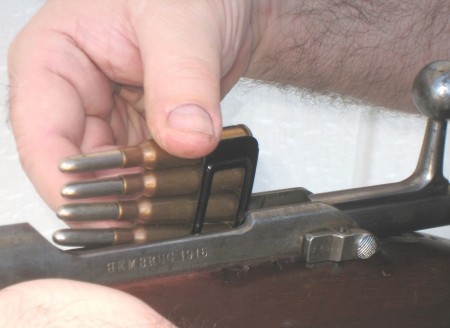
In shooting the gun I found recoil to be no problem what so ever. The trigger like most military had some travel prior to let off. Pull wasn’t bad and was consistent making it that much easier to shoot. While the sights are adequate for target shooting they leave a bit to be desired at least with my aging eyes. Accuracy is on par with other 6.5’s that I have shot. On a good day I can put 3 shots into 2 to 2 &1/2 “ at 100 yards with the most accurate bullets. The 140’s and 160’s seem to be the most accurate at least in my rifle. The lighter slugs are ok especially if you seat them out a bit. You should keep at least 1 caliber of bullet in the neck to ensure proper powder ignition. Even with a scope I doubt that it would do much better then 1” at 100 yards 3 shots. Of course, that is very respectable accuracy and few people can shoot better then that from hunting positions.
With the loads and bullets available, the Dutch is very adequate for some types of big game hunting. Any deer that ever walked would fall to the 120 to 140 grain slugs. Depending how good your eyes are you can use the iron sights for shots out to a couple of hundred yards. The rest of us would be better served by a scope at longer ranges. A 120 grain at 2600-2700 feet per second should do nicely. If you were doing to hunt elk with it I would go with a 140 grainer probably a Nosler. Some would say it’s too light for elk but with a patient stalker and good shot it would do. After all some proclaim the .257 Roberts an adequate rifle for elk. The 160 grain with its high sectional density would handle a black bear and do a good job of it. In spite of all the new offerings coming out bullet placement is still the most important single factor in a successful hunt. The 160 grain round nose launched at 2400 feet per second has 2046 foot pounds of energy. At 200 yards energy still clocks in at 1205 ftlb. Since many people consider 1000 pounds minimum, looks like a 200 yard load for suited game animals. A 140 grain at 2500fps produces 1943 foot-pounds of energy at the muzzle while 200 yards shows 1426 ftlb easily making it a 200 yard deer load. The 120gr at 2600fps shows 1846 ftlb at the muzzle while at 200 yards energy drops to 1150 ftlb, still enough for White Tail Deer.
The 160gr when sighted in at 100 yards drops about 6.5” at 200 yards. The 140gr under the same situation will drop about 5.5” while the 120 will drop about 4” when sighted in at 100 yards. Such a trajectory makes it a very useful 200 yard gun. With a scope (ed: the SPECIAL Hell) and good shot placement the careful hunter could stretch it to about 250 yards. In good conscience I can’t recommend much over that for sure clean kills. Of course most big game animals are shot within 200 yards of the hunter.
The 85 and 100 grain bullets should be relegated to small deer and pests. They lack the sectional for good penetration and longer shots. The 85 grain zipping out at 3100 feet per second produces about 1600 foot pounds of energy. At 300 yards it drops to about 950 ftlb making in a decent varmint load but not for big game. If sighted in at 100 yards will drop about a foot at 300. With a scope and proper bullet placement there is no reason that a 300 yard shot can’t be done. A lead bullet load would be an excellent small game load where legal to use. The report is very low and the bullet will not destroy much meat. Such a long lead bullet would be good out to about 100 yards. The trajectory would be a lot different then a full power load. The lead bullet in my gun turned out to be very accurate as long as velocities were kept low. Drop at 100 yards with the lead load would be 12″ to 18″ lower then the full power jacketed offerings. With the high sectional density of the 140 grain penetration would be surprising ever at low velocities.
In power it is only slightly less powerful then the 260 Remington. Loaded to the same pressures and same barrel length there would be little difference between the two. I didn’t try and squeeze the last foot pound out of the Old Dutch rifle as there was no reason to do so. As it is I would take it hunting any time as it is short, light and handy. As you get older, lighter and handier rifles make a lot of sense especially when shots are taken at normal range. If you have a chance to add one of these to your collection by all means do so. If you pass it up a great opportunity to own an interesting rifle will be passed up.
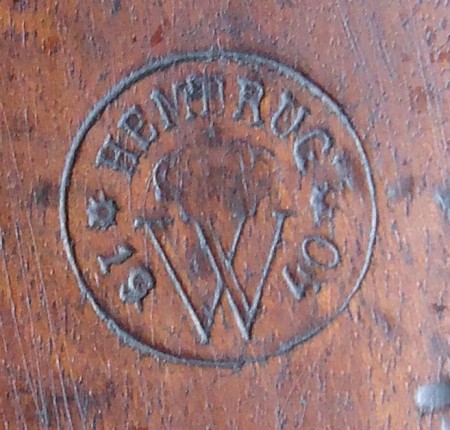

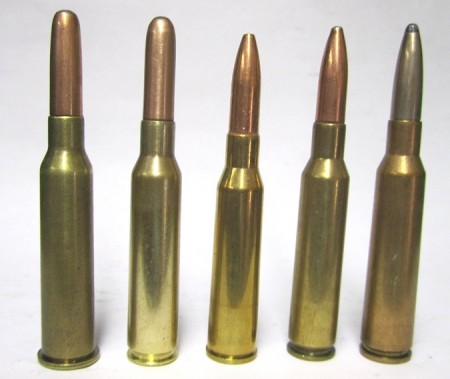
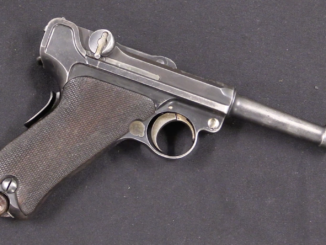
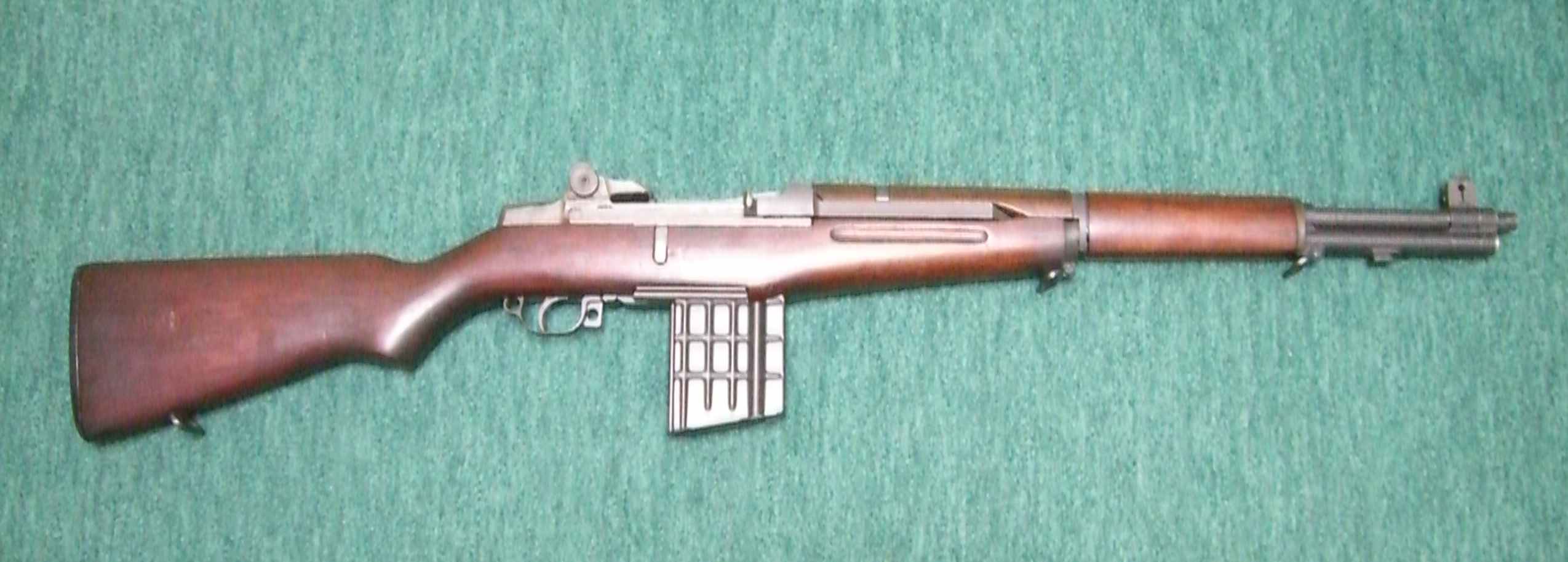
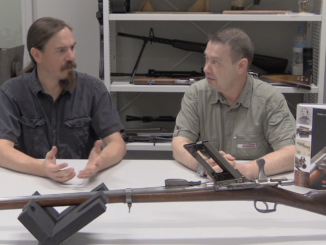
That carbine is a Dutch Mannlicher if I’m not mistaken. In this case, the action was changed from straight-pull to turn-bolt. The signs of a Mannlicher-style action apart from the bolt are the magazine and en-bloc clip, though the Italian Carcano also uses this particular style, as does the Gewehr 88. The only problem with the original clip setup is that the magazine can get clogged by debris from below. DO NOT EVER GET MUDDY WITH THIS!
Does anyone have wood thickness penetration figures for the cartridge fired from a long rifle? I know that a long barrel on a rifle reduces wasted propellant and muzzle-flash.
“twist of 1 in 7.87″ ”
7.87″ is 200mm in metric system
If you want see more Dutch rifles go:
https://www.arma-dania.dk/public/timeline/_ad_gevar_list.php
P.S.Please correct the ballistic data table, now it is hard to read.
Those aren’t Dutch, they’re Danish
Load Bullet Velocity Comments
8 x Herco 85 Grain Sierra H.P. 1255 Pest Load
43 x VV 150 85 Grain Wincester 3068 Good Load
37 X IMR 4895 85 grain Sierra h.p. 2673 decent load
41 X IMR 3031 85 grain Sierra h.p. 2979 max
35 X IMR 4895 100 grain Hornady 2578 ok
38 X RL # 19 100 grain Hornady 2365 mild
40 X AA 4350 120 grain Remington 2436* deer load
37 X IMR 3031 120 grain Remington 2660 deer
39 X VV 150 120 grain Remington 2550 good deer load
32 X IMR 4895 129 grain Hornady 2445 deer load mild
39.5 X RL# 19 129 grain Hornady 2133 mild
36 X IMR 3031 129 grain Hornady 2495 deer load **
38 X RL# 19 140 grain Remington 2032 quite mild
8 X Herco 140 grain cast 1221 consistent
39 X AA 4350 140 grain Remington 2325 * mild
37 X VV 150 140 grain Remington 2308 mild **
35 X VV 150 160 grain FMJ 2240 ok
37 X AA 4350 160 grain Hornady 2533 * ok
38 X AA 4350 160 grain Hornady 2253 mild **
36 X H 4895 160 grain Hornady 2328 max
Load Bullet Velocity Comments
8 x Herco 85 Grain Sierra H.P. 1255 Pest Load
43 x VV 150 85 Grain Wincester 3068 Good Load
37 X IMR 4895 85 grain Sierra h.p. 2673 decent load
41 X IMR 3031 85 grain Sierra h.p. 2979 max
35 X IMR 4895 100 grain Hornady 2578 ok
38 X RL # 19 100 grain Hornady 2365 mild
40 X AA 4350 120 grain Remington 2436* deer load
37 X IMR 3031 120 grain Remington 2660 deer
39 X VV 150 120 grain Remington 2550 good deer load
32 X IMR 4895 129 grain Hornady 2445 deer load mild
39.5 X RL# 19 129 grain Hornady 2133 mild
36 X IMR 3031 129 grain Hornady 2495 deer load **
38 X RL# 19 140 grain Remington 2032 quite mild
8 X Herco 140 grain cast 1221 consistent
39 X AA 4350 140 grain Remington 2325 * mild
37 X VV 150 140 grain Remington 2308 mild **
35 X VV 150 160 grain FMJ 2240 ok
37 X AA 4350 160 grain Hornady 2533 * ok
38 X AA 4350 160 grain Hornady 2253 mild **
36 X H 4895 160 grain Hornady 2328 max
argh, tablised the ballistics information, html info got stripped and now I can’t delete my old comments 🙁
Hey, that’s alright, swm. At least you caught it and noted things accordingly. We all make mistakes from time to time, even when we know better. I’ve caught myself — and others have caught my slip-ups — when I’ve occasionally meant to say one thing but left out or deleted some lines while editing and changed the whole meaning of what I wanted to say, usually because I was tired or in a hurry and didn’t double check my posts! Potentially embarrassing, especially if it’s about a subject which I know very, very well, but I suppose that’s just being human, faults and all.
interesting read! Nice to read something from my home. How would this rate against the other rifles of its day? Just a general idea, bad/medium/good
The Dutch field manual from 1934 lists the muzzle velocity for the rifle as 723 m/s (2372 fps) and for the carbine as 670 m/s (2198 fps). This is for the 10.5 g (162 gr) round nose FMJ bullet.
Really nice to see Bob Shell featured on FW. I had mentioned his work in adapting and reloading rare and obsolete cartridges a while back in one of my comments in an FW article ( I forget which ). Bob Shell’s Blog is a terrific site and a fountain of knowledge for anyone interested in all aspects of small arms cartridges and related ballistics, and it has always ranked as one of my favorite all-time “go-to” reference sources.
“shooting vintage military rifles is dangerous, and will probably kill you in a spectacular manner”
…this statement is a perfect example of what I love about this site.
– now let’s go shoot some vintage military rifles, hooray!!!
If I gotta go,I want it to be in a spectacular manner!
I use loading data for the 6,5 Manlicher Schönauer cartridge-
I have only ever seen ONE 6.5 Dutch Mannlicher in a gunstore here. That was back in the early ’90s at a little gunstore that apparently had no regular hours. They eventually went out of business to be replaced by a pizza shop.
I thought about getting one back in the ’90s when some of them were being advertised in Shot Gun News. I passed because of the unavailability of anything but original corrosive ammunition. I had no idea that you could make brass from .303 British. That information is probably in “Handbook of Cartridge Conversions”, but by the time a friend bought a copy, the guns were long gone.
I have one that I bought in the early 90’s. No one knew what it was, just that nobody made brass for it. I had the chamber resized to 6.5X55 Swedish Mauser and shot it single shot. No problem with pressure or extraction, even without a rimed case. I found a clip for it in 2013 but the Sweedish brass would not stay in the clip. I start with 30-40 Kraig brass, full length size it and trim for length. The Kraig brass works well, in the clip and do not have the problems with the primers like the 303 British cases do. I don’t know what to call it though 6.5X40 kraig or maybe a 6.5X55R? I built my own side mount for a scope. I started with a 30-30 Winchester scope mount upside down, it is curved on one end for a 1 inch scope so the radius matches the radius on the side of the reciever the upper end is flat and allows for plain weaver mounts. I put a 4X weaver scope on it that I took of my 22. It fits far enough off side to clear the bolt without bending the handle and still allows the use of the iron sights. I use it to hunt white tail deer in Texas. It works great.
First off, the case does not “hit the receiver” for ejection. The Dutch rifle has a sliding ejector on the bolt body head, similar to the Mannlicher-Schoenauer, which hits the bolt stop; the Rumanian rifle’s ejector is similar to that of the Krag.
The Dutch and Rumanian cartridges, while being otherwise identical, are not the same. They differ in rim thickness. The Rumanian version has a the thinner rim (.049″), and was the commercialized version.
The Steyr turn-bolt rifles have no affinity to the Mannlicher straight pull bolt action. They are simply improvements to the German M88 Commission rifle, with the ultimate improvement being the Mannlicher-Schoenauer.
The other way around, mate.
The Romanian had an extensive trial of one year hence the model 1892 which is factory standard and similar to the dutch rifle.
Adopted Md 1893 Romanian rifle had a 1.80 mm rim thickness and the dutch a 1.57-1.63 mm rim
The Romanian rifle has a way better ejector and that was part of the modifications they required along with the magazine reinforcement.
You cannot load the clip if the bolt is not inserted and more important you cannot introduce the bolt without the bolt head like in the Gewehr 88.
Overall, as we all know, the dutch thought they can save money and adopted the standard Steyr model in 1895. Save here, there, anywhere and ended up with 9 models.